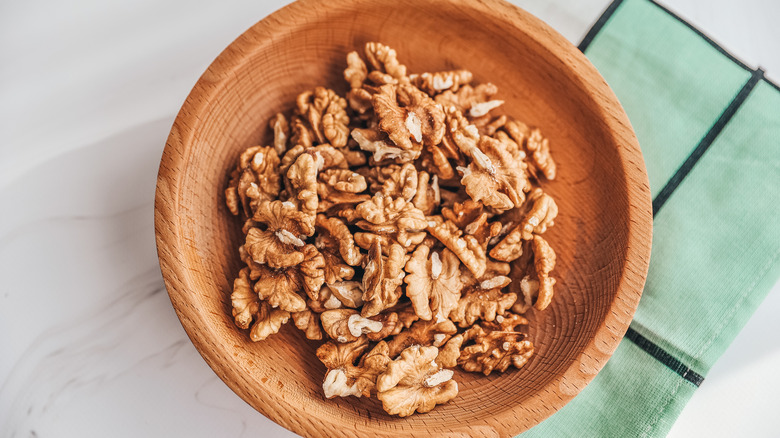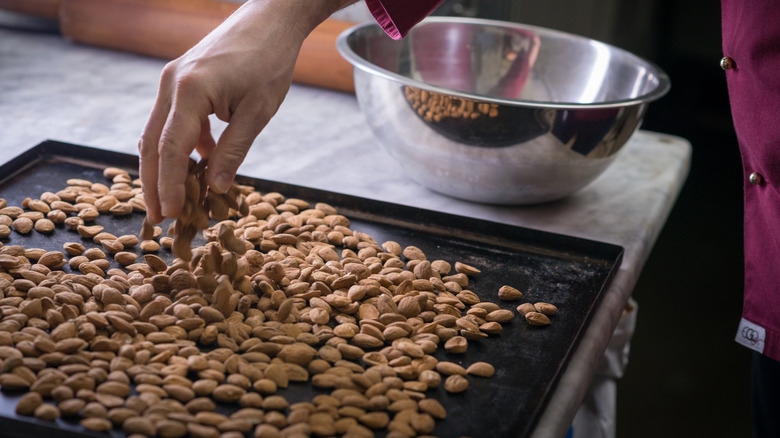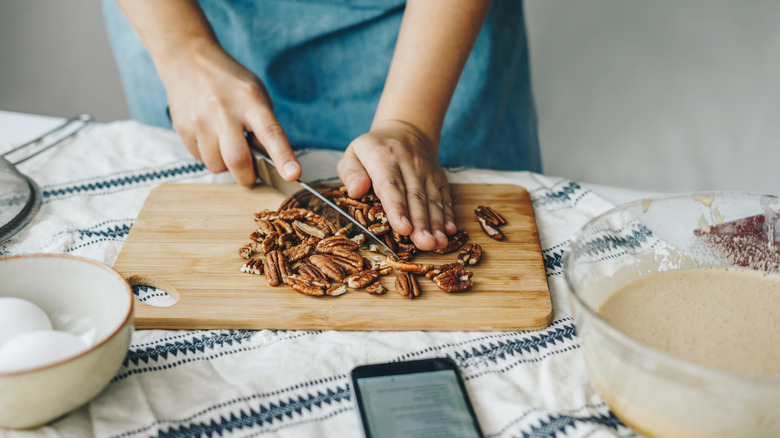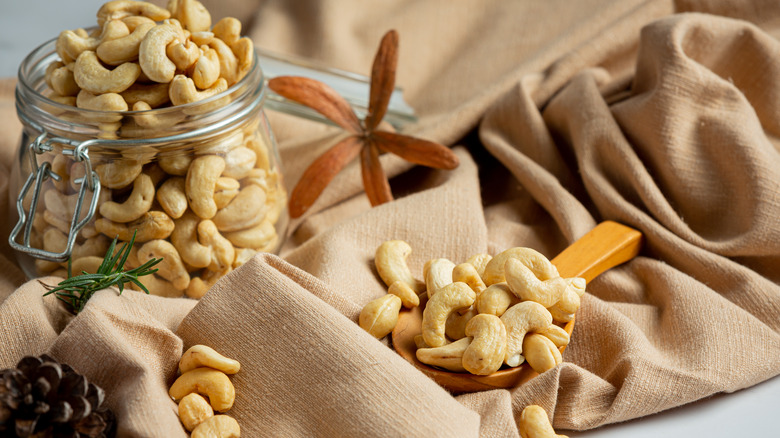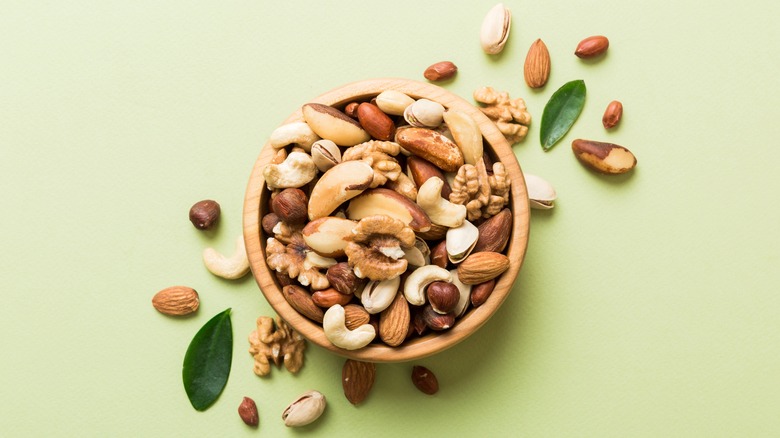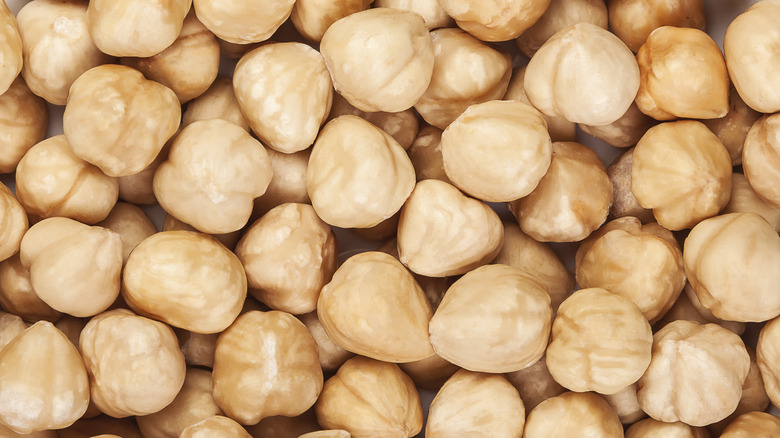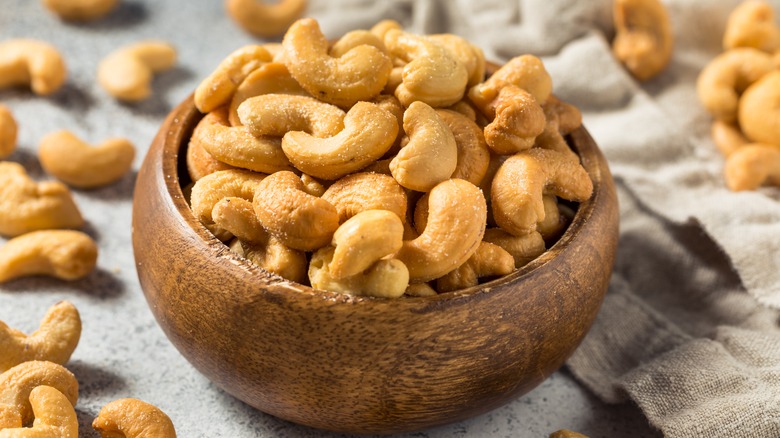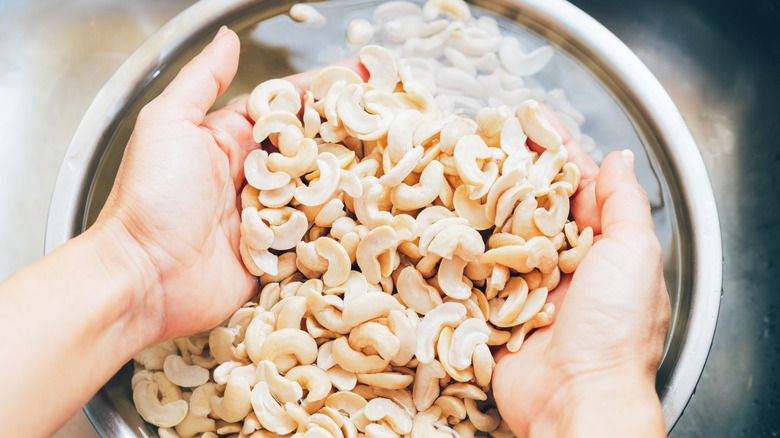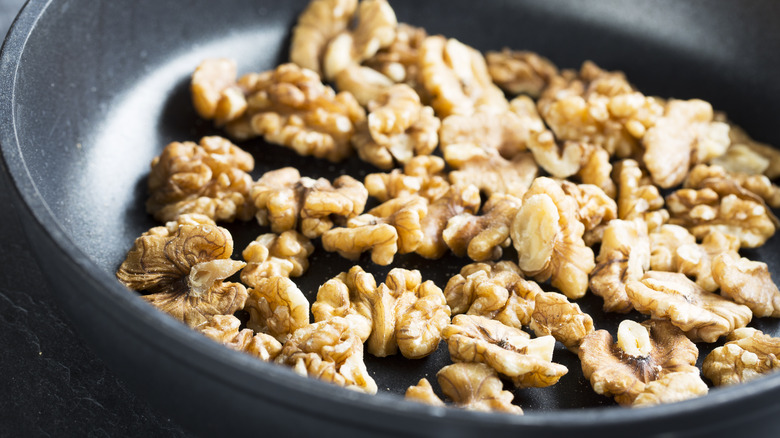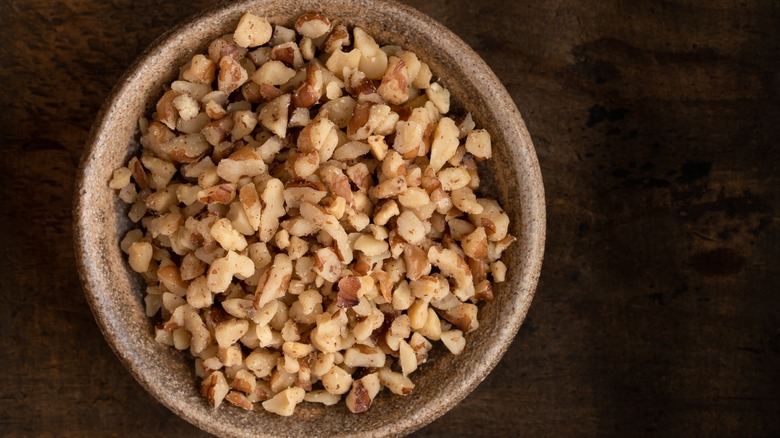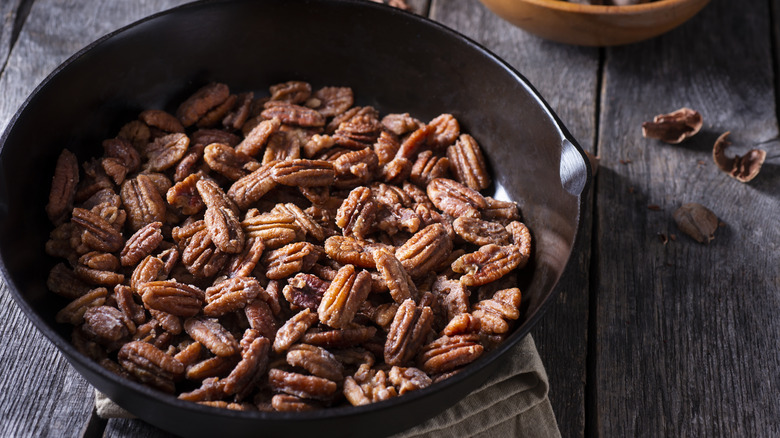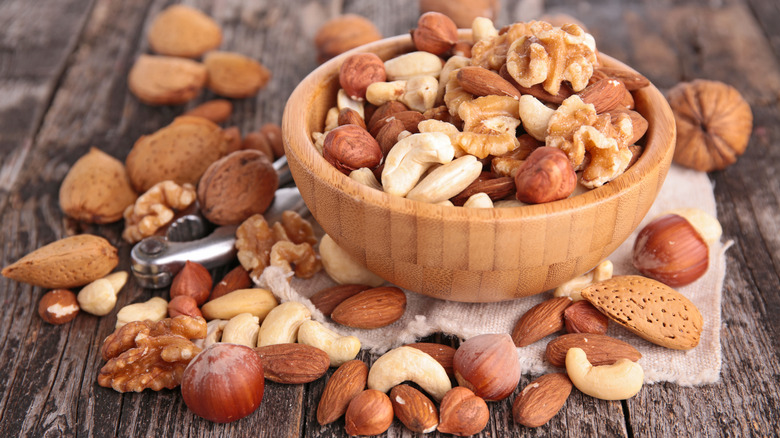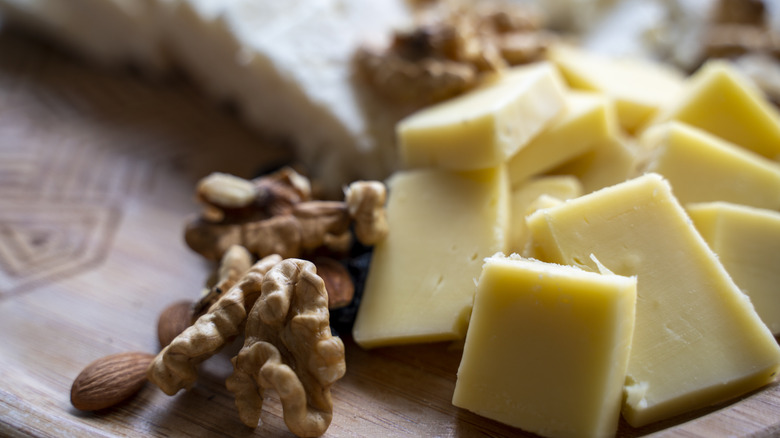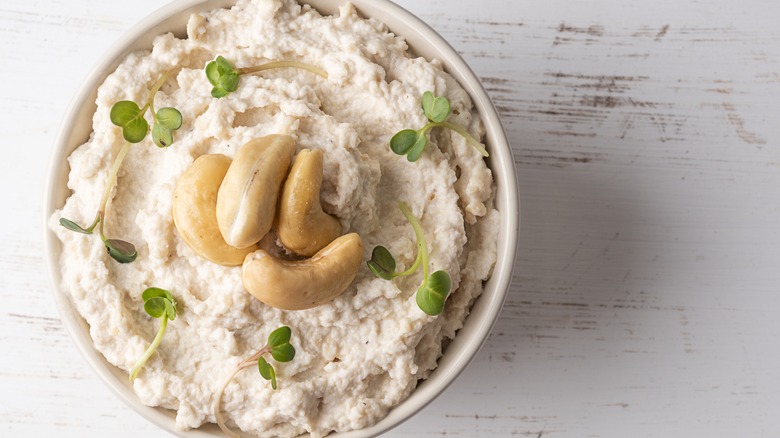13 Common Mistakes You Should Avoid When Cooking With Nuts
Nuts aren't just for snacking on, folks. When used right, they can form an integral part of a meal, elevating the sensory experience of a dish while bolstering its nutritional content. Nuts are excellent for providing gluten-free crunch to food, both as a coating for recipes ranging from cakes to fried fish, and as an addition to meals like curries and stews. When toasted, nuts can also give any meal a warm complexity that underscores your other flavors. As nuts are high in fiber, monounsaturated fats, and essential minerals like manganese, copper, and selenium, throwing them into a dish is also a great way to make any meal a little more wholesome.
If that wasn't all, there are plenty of creative uses for nuts in your kitchen, where they can be added to anything from cocktails to dips. So what's the catch? Well, they're surprisingly difficult to cook with. When used incorrectly, nuts can add a whole lot of nothing to your meal, and totally lack flavor. As high-fat foods, they're also prone to burning if handled poorly and can introduce some serious flavor clashes into your meals. By staying wise to the big mistakes people make, though, you'll never go wrong.
Forgetting to toast your nuts
Nuts are tasty enough in their raw state, but when they're toasted, they really shine. Browning nuts helps to develop their flavor, turning their regular, slightly creamy tones into deep, complex combinations of tastes. Toasting any type of nut unlocks its earthiness in full force, which can then help to round out your food's flavor profile and provide a balance to acidity and heat. Using raw nuts in your meals, though, will mean you don't get any of this layered flavor, and they're likely to get lost among the other, stronger-tasting ingredients in your food. You also miss out on the extra crunch you get when you toast nuts, as the heat helps to crisp them slightly.
You've got three main options when it comes to toasting nuts: Frying them in a skillet, popping them in your oven, or blasting them in the microwave. Frying them may seem like a speedy alternative that gives you a clear view of your nuts while they're toasting, but it can be a high-risk method that burns them in seconds if you're not careful. The oven, on the other hand, allows you to go lower and slower with your browning, and toast more nuts in one go — but you do lose the visual aspect. While using the microwave can be fast, bear in mind that you'll have to stir the nuts pretty regularly and blast them in shorter intervals.
Cooking with pre-chopped nuts
For folks out there who're pushed for time (so pretty much all of us), pre-chopped nuts can seem like a game-changer. Using them, though, may not produce as good of a flavor as you think. Although pre-chopped nuts are super convenient, they also lose their freshness way quicker than whole nuts. If you don't use nuts in your cooking frequently, this could mean that the big bag of chopped almonds you just bought could be stale by the time you use them again.
Lack of freshness can also equate to a lack of flavor, and this is compounded by the fact that pre-chopped nuts are usually untoasted. As these chopped pieces can sometimes be quite small, trying to toast them can result in them burning quickly, ruining your meal. On top of this, when you buy pre-chopped nuts, you have little control over how finely they're chopped, and you're pretty much stuck with the size the manufacturer has decided for you. The solution? Just chop your own. Toast your whole nuts before allowing them to cool completely, then chop them using a sharp, heavy knife or a food processor. Your food's flavor will thank you for it.
Using stale or rancid nuts
Nuts can be one of those food items that sit in the back of our pantries for a long time between uses. Unfortunately, though, they don't last forever, and despite being shelf-stable, they can go bad just like any other food. Because nuts are so high in unsaturated fats, they first tend to go stale, and then turn rancid, when left at room temperature. Although stale nuts can sometimes be revived by being toasted, rancid nuts will have a sour, unpleasant flavor, and can't be salvaged.
The tricky thing, though, is that it can be super hard to tell when a nut has gone bad without biting into it, because their physical appearance may not change that noticeably. Rather than risk it, you're far better off storing your nuts in a way that keeps them fresh for longer. Popping them in the freezer in an airtight container is your best bet. When frozen, nuts retain their freshness for up to a year. They can also be easily decanted whenever you need them, as they won't clump together when at sub-zero temperatures. For easier access, you can also keep them in a jar in your fridge, where they'll stay fresh for up to six months.
Thinking that all nuts are equal
Unless you're a nut aficionado, it's easy not to notice the nuances in flavor that differentiate their different varieties. It's regrettable, however, when people just substitute one type of nut for another in recipes without considering the overall impact. The truth is that each nut is slightly different, and when you're using a lot of them in a dish, that flavor will start to stand out, especially when they've been toasted.
Take the difference between hazelnuts and cashews, for example. Hazelnuts give off an ultra-nutty, warm, slightly woody scent and flavor when toasted, whereas cashews have a gentle butteriness that almost caramelizes upon being cooked. Substituting either of these for each other will give your food an altogether different flavor. In certain recipes, where nuts are heavily used, it may also alter your food beyond recognition. If you don't believe us, try making cashew cream with hazelnuts and see what happens.
Importantly, these substitutions may not always be a bad thing. It can be pretty exciting to mix things up by using different nuts and create brand-new flavor combos. However, we'd always recommend you try and make the effort to grab the right nuts, to save you from any disappointment with your dish.
Forgetting to remove the skin from certain nuts
Some nuts can be pretty annoying to prepare for cooking, and the ones that have skin on them are by far the most irritating. If you're tempted to skip removing the skin from your hazelnuts, almonds, or walnuts, however, we'd advise sticking with it. Leaving your skins on your nuts before adding them to a meal can introduce unpleasant flavors and textures into your food, with hazelnut skin being particularly bitter and flaky. Almond skin, while less bitter, can also fill your food with little chalky particles that can be pretty unpleasant to have to chew through.
Before toasting your nuts and adding them to food, therefore, we would always recommend skinning them if possible. A quick way of doing this is by parboiling your nuts in a mixture of water and baking soda for a few minutes, which loosens the skin in no time. You can then use a soft, clean dishcloth to gently rub the skin away from the nut. A soft-bristled brush should also do the trick nicely and will be useful for getting into all of the cracks in the nut itself.
Using salted nuts in all your recipes
Salted nuts are the ultimate bar snack (or midday snack, or pre-dinner snack, or — okay, you get the point). When placed into a recipe, though, salted nuts are far more likely to ruin it than make it better. "Salted nuts can completely disrupt the balance of a dish, so it's best to buy nuts that are raw and unsalted and then roast and season them yourself," says the Institute of Culinary Education's lead chef of online plant-based culinary arts and food operations Emilie Berner, via Mashed.
The problem with salted nuts is that it's way too easy for them to tip the salt content of your meal into uncharted territory. As reducing sodium in food can be hard once it's been added, you might simply end up with an overly salty, unpleasant meal. This effect can be even more pronounced if you're using nuts in sweet dishes like baked goods. Berner recommends always checking the packages when buying nuts carefully, as sometimes it can be hard to tell whether a variety is salted or not just by looking at it. You should also pay close attention when buying loose nuts, for the same reason.
Forgetting to soak your nuts
You might think that soaking nuts is a hassle, and if you're just eating them as a snack, we get it. If you're using them in your food, however, forgetting to soak them means you're failing to get the best flavor out of your food. Soaking nuts helps to remove any impurities from the skins and reduces their tannin content. These tannins give your nuts a slightly bitter taste, and after soaking them and rinsing away any leftover water, you should find that they're way smoother and gentler-tasting. As a result, your food won't develop an undercurrent of astringency.
Soaking nuts will also make them softer and easier to handle. You just need to make sure you leave enough time to soak them fully. While some nuts can benefit from as little as 20 minutes of soaking, harder nuts will take longer and could require soaking overnight. Make sure you pop your nuts in an airtight (and, of course, leakproof) container when soaking them. Once you've drained them, you should also make sure they're fully dry before you try and toast them, so they don't just end up steaming. Pat them dry with a paper towel or clean dishcloth, or leave them to air dry.
Over-toasting them
Toasting your nuts is almost always a good thing — unless you go overboard. Nuts can go from perfectly-toasted to burnt in just a few seconds, with their high fat content hastening their cooking speed pretty considerably. When nuts burn, the flavor difference is profound and unsalvageable, and they'll be incredibly bitter and unpleasant to eat. While this is more likely to happen when using direct heat, like frying them in a skillet, it can also happen when toasting them in the microwave or on a baking sheet.
To avoid this, it's highly important to keep an eye both on your nuts and on the time it takes to toast them. Start with a slightly shorter time than you think: If your instructions say toast for 20 minutes at 300 degrees Fahrenheit, for example, we'd recommend starting with 15 minutes and then taste-testing them at this point. Once you've got a feel for how done they are, you can then pop them back in for however long they need. While taste and scent are good indicators of how done your nuts are, it can also be a good idea to slice one through and check out its color. A light-brown tone throughout will indicate that it's pretty much done.
Chopping nuts when they're warm
If you're in a hurry to get cooking, nuts can quickly become a nuisance, what with having to toast them perfectly to extract their flavor and all. So we can understand why you'd want to get chopping when your nuts are straight out of the oven — except that doing so will probably undo all your hard work. As nuts toast, their oils rise to their surface, which partly helps to brown them. Once you take them off the heat, this oil then sinks back into the body of the nut, reinstituting its full flavor.
Chop them before they've cooled, though, and you might find that this flavor is poorly distributed. You may also find that your nuts are slightly tricky to chop, and get somewhat gummy or clump up on your knife, particularly if they haven't been toasted through entirely. The best thing to do is to account for the time it will take your nuts to cool fully, and then leave them alone. While you can speed up the process slightly, by placing them somewhere cool, patience is your best asset here.
Toasting your nuts in fat
Because most things require fat to brown in a skillet or oven, we can understand why you'd think that nuts would too. However, coating them in oil or another type of fat before cooking them can ruin their flavor. Nuts have a super-high monounsaturated fat content, and these fats will rise to their surface as they heat up, giving them natural lubrication. Add extra fat on top of that, and you'll just end up making them taste too oily and could make their cooking times unpredictable.
Having said this, there are certain situations where you will need to add extra fat. When making spiced or coated nuts, for example, adding fat will help your ingredients stick to them properly. If you do this, though, be careful about both the amount of fat you use, so you don't make them greasy, and the temperature you're cooking the nuts at. Many spiced nuts recipes use butter, which has a low smoke point and can burn quickly and make your nuts taste bitter.
Roasting different kinds of nuts together
If you're making a dish with several types of nuts, roasting them separately can be a real bore. Unfortunately, that may be the only way to prevent some of them from burning. When roasting nuts, you have to remember that each type of nut has different dimensions and thickness, as well as a different fat content. All of these can be factors in how quickly they toast, and some brown way more quickly than others.
Some of the differences in browning time can be pretty drastic. Tiny pine nuts, which are commonly used in pesto, can fully toast in as little as 18 minutes. On the other end of the spectrum, macadamia nuts can take half an hour to brown, with cashew nuts needing a similar amount of time to toast. While you can chop up larger nuts to match the size of the smaller ones, a far better bet is to separate your nuts onto different trays and pop them on different levels of your oven. Then, when one type of nut is finished toasting, you can just pull it out and let the others continue cooking.
Forgetting your pairings
While nuts are fairly versatile ingredients, it's important to remember that each of them has a distinct flavor, and is best used with certain foods. As such, you shouldn't forget your pairings. The flavor profile of almonds, for example, turns from buttery and rich to slightly sweet when toasted. This makes it a perfect fit as a crust for both savory and sweet foods, adding contrast to salty fish like salmon or boosting chocolate cake to even more sugary heights.
Hazelnuts, meanwhile, benefit chocolate differently, combining with the cocoa notes to deepen the chocolatey flavors. Where they're less useful, though, is in savory applications. The same goes for pecans, which have both a creamy top note and a gently woody taste that work very well in desserts. Walnuts, with their earthiness, go well with fresh fruits but are also a perfect pair for cheese, where they can add a deep undertone. The best thing to do is to use your instinct when it comes to flavor. If you're unsure about putting those pistachios in your sauce and know that another nut would be better, you're probably right.
Assuming they always have to be crunchy
One of the main selling points of nuts is, of course, their crunchiness. However, only valuing them for their crunch factor can mean that you're missing out on using them in exciting, innovative ways. Cashews, for example, can be the base ingredient in a plant-based cream substitute — because cashews have such a buttery-smooth taste and rich fat composition, you can blend them up to make cashew cream, which can then be used in everything from chicken alfredo to desserts to vegan queso.
You also shouldn't forget nuts' ability to provide bulk to your recipes. Ground almonds or Brazil nuts, for instance, can be used as a thickener in stews, soups, and curries, helping to provide volume to your cooking liquid without adding flour. They can also be used in baking recipes, and are a great substitute for people who are gluten intolerant or simply want a less doughy crumb. Ground almonds are also a key ingredient in marzipan, where they help to firm up the confection while simultaneously providing its characteristic nutty, slightly sweet flavor. By grinding your own almonds to use in marzipan, you can make this flavor even more intense and fresh-tasting.
Static Media owns and operates Daily Meal and Mashed.
